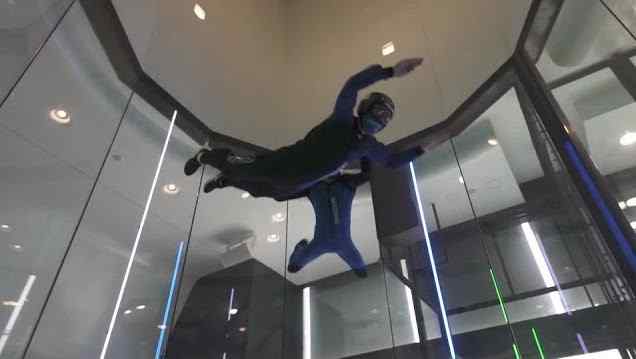News
The Disabled Fly Free-of-Charge with the “Windtunnel Handifly Project”
So far, the nonprofit initiative is supported by nine wind tunnels around Europe, and plans to hold a competition in 2022.

[the_ad_placement id=”article-above-content-mobile-only”]
A group of visually impaired fliers hopped in the Windoor Barcelona wind tunnel on Wednesday, October 20, to try indoor skydiving for the first time.
“Look, [I’ll] explain it in one word: Incredible,” said Xavier de la Rosa, one of the visually impaired fliers who entered the 14-foot (4.3 m) recirculating Barcelona tunnel. “It was really a new, innovative, and very gratifying experience. It felt like being in a pool of water, but you can breathe. You feel completely free. You can go from side to side and there is nothing to stop you. It’s not like having your feet on the ground, because [then] you don’t have that sense of freedom. You have to always be touching something. But not here. Here you are only touching the air. It was really a great experience.”
The flights were supported by Spanish nonprofit ONCE (“Eleven”), and were part of the Windtunnel Handifly Project. Handifly is a nonprofit initiative spearheaded by the French Parachuting Federation (FFP) and the European Commission to introduce people with disabilities to skydiving (both indoor and outdoor) free of charge. So far, the initiative is supported by nine wind tunnels in six countries around Europe. Four tunnels in France, two in Spain, one in the Netherlands, one in Italy, and one in the Czech Republic all have joined the project.
The Handifly Project consists of two stages. First, over 9,000 free flights will be offered for people with disabilities at the participating wind tunnels around Europe, with the eventual goal of enabling “people with physical disabilities to compete in complete autonomy.” The second stage and culmination of the project will be what the FFP is calling “the first wind tunnel world competition in history,” Handifly Race, which will be held in Aix-Marseille, France, from May 18th to 21st, 2022.
Emma Perez, another of the disabled fliers in Barcelona, spoke about the unique accessibility of indoor skydiving for people with disabilities. More than almost any other sport, she said, indoor skydiving is perfect for the disabled. “You don’t need anyone’s help to do it,” she said. “You can do it completely on your own. Right now, I need help because I don’t know how to control myself, but after seeing how [professional fliers] go in there and do acrobatics… It’s just fantastic. You don’t need anyone. Not even a guide or anything like that.” You can watch a video of the fliers here.
Windoor Barcelona representative Albert Canals said that over 25 fliers have participated at his wind tunnel so far. “At Windoor, we’ve always liked the idea of democratizing sport, in this case, indoor flying. [These fliers] had feelings of joy, euphoria, and adrenaline,” he said. “I’m sure they’ll be coming back.”
Disabilities covered under the Windtunnel Handifly Project include:
- Loss of muscle strength
- Loss of passive joint mobility
- Impairment of a limb
- Difference in leg length over 7cm
- Small size (ex. achondroplasia, growth hormone dysfunction, and osteogenesis imperfecta)
- Hypertonia
- Ataxia
- Athetosis
- Visual impairment
- Intellectual disability
More information about Windtunnel Handifly, including a full list of qualifying impairments, can be found on the project’s homepage HERE.
Published: October 28, 2021 | Last Updated: October 28, 2021
Don’t miss an update!
Join our mailing list for the latest indoor skydiving updates delivered directly to your inbox.
"*" indicates required fields

